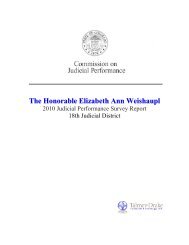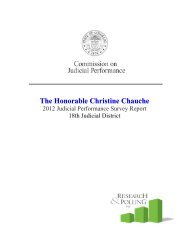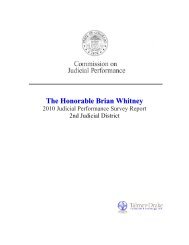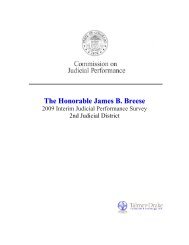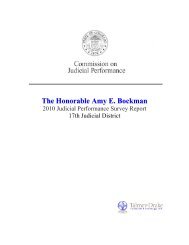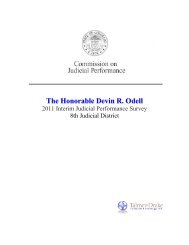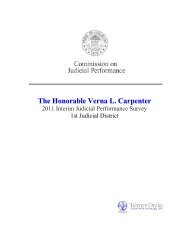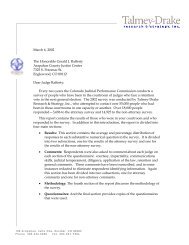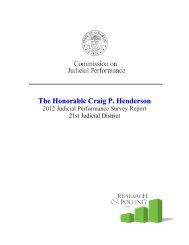The Honorable Daniel J. Kaup - Mountain Legal â Colorado ...
The Honorable Daniel J. Kaup - Mountain Legal â Colorado ...
The Honorable Daniel J. Kaup - Mountain Legal â Colorado ...
You also want an ePaper? Increase the reach of your titles
YUMPU automatically turns print PDFs into web optimized ePapers that Google loves.
Depending on the number of names available to be sampled for each judge, a randomsample was drawn if the quantity of potential respondents was large. On the other hand,if the count of possible respondents was small, all potential respondents were includedin the sample. Where a person had been in more than one judge’s courtroom, theselection criteria for which judge he or she would be sent a questionnaire was generallyfor the judge in whose courtroom the potential respondent had been in most often.Each person whose name was sampled for the Non-Attorney Survey was mailed aninitial postcard informing the recipient that he or she would be receiving aquestionnaire. Two to three weeks after the post card was mailed, the potentialrespondent was sent a personalized introductory letter and a questionnaire with apostage-paid return envelope. If the person did not respond, a second questionnaireand letter were sent approximately four weeks later. Questionnaires are barcoded, andif a respondent mailed back two questionnaires, the second one was deleted from thedata file.Starting in 2010, non-attorney section of the Judicial Performance Survey reports arebased on a moving average, or rolling sample, of data collected over a period of timeequal to the judge’s term of office: six years for a district judge and four years for acounty judge. To use a district judge as an example: as survey data is collected it ispooled together for six years. After six years, as new data is added to the judge’s surveyresults in the first quarter of the seventh year, the oldest quarter of data in the pool isdeleted.<strong>The</strong> current data for all judges only goes back as far as 2005—or the year the judge tookthe bench—therefore the rolling of the data only affects the county judge sample in the2010 reports. 2b. Questions:<strong>The</strong> survey questions asked respondents to use a grade of A, B, C, D, or F to assess thejustice or judge's performance on twelve aspects of judicial performance (SeeQuestionnaire section.) <strong>The</strong>se grades were then converted to a numerical scores whereA = 4, B = 3, C = 2, D = 1 and Fail = 0. <strong>The</strong> A through F scale was chosen because it isalmost universally recognized and understood. This makes it easy for respondents tocomplete their questionnaire, and for the public to interpret the results.Respondents were also asked if they considered the judge biased toward the defense orprosecution in criminal cases. In a final question, respondents were asked to indicatehow strongly they would recommend that the justice or judge be retained or notretained in office.A copy of the questionnaire is included in the last section of this report.2 <strong>The</strong> State Commission on Judicial Performance authorized continuous surveying in 2007. Prior to 2007 data wasonly collected in the odd numbered years before the retention reports were issued. <strong>The</strong>refore, while data wasgathered in 2005, 2007, 2008 and 2009, and used in this report, there was no data collected in 2006.2010 Judicial Performance Survey Report23



